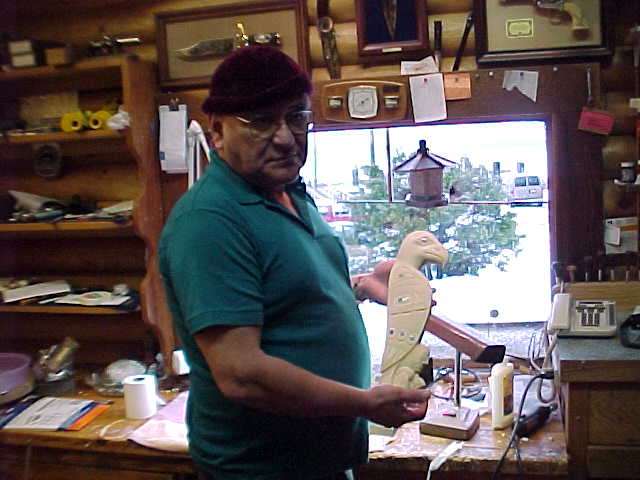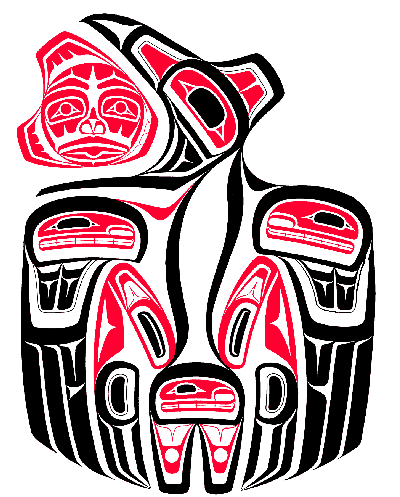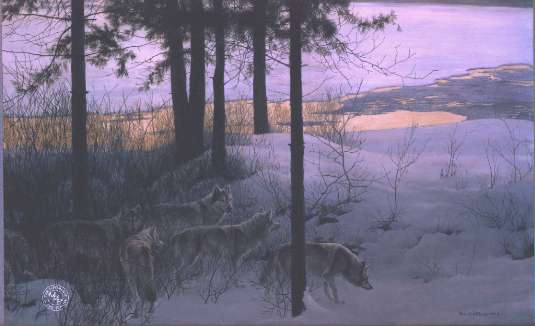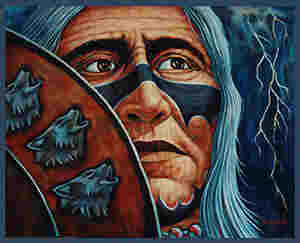
Sammy Robinson, brother of Gordon Robinson, Master Carver at Kitamaat Village, with Eagle Carving
TALES OF KITAMAAT VILLAGE
These tales are exerpts from a book entitled Tales
of Kitamaat Village by Gordon
Robinson. The first publishing was in 1956
and the most recent publishing was in 1998.

Sammy Robinson, brother of Gordon Robinson, Master Carver
at Kitamaat Village, with Eagle Carving
THE STORY OF HUNCLEE-QUALAS OR THE FOUNDING OF KITAMAAT
In the early days a group of braves from what is now Port Simpson near Prince Rupert were on a hunting trip and in their wanderings they went into the Kitiamaat Arm and became lost. A search party made up of their relatives came up to the arm looking for them but while still a few miles from the head of the inlet, the river, which they could see from a long distance, suddenly opened what looked like, to their imaginative minds, a huge mouth then slowly closed it again. The search party fled and went home where they told of the monster which must have, they believed, killed their comrades. During the following years the news of the monster spread up and down the coast and there was not one hunter brave enoughto go near the Kitamaat arm.
In a large village called Soo-ma-halt near the head of Owee-keeno lake (Rivers Inlet, BC) there lived a young man named Waa-mis who found that the maidens in the neighbouring village were more attractive than those of his own. He married into Nacgils, a village farther down the lake, and with all his relatives moved there where he lived happily several years.
One evening Was-mis and his wife were sitting on the opposite sides of teh fire arguing. He picked up a small stone and in a playful manner tossed it at her but it struck her on the temple and killed her. The chief of the village called a meeting of his braves and in the meeting deicded to punish Waa-mis by putting him and all his relatives to death. One of the braves, who was from Waa-mis' own village, told him about the plan and advised him to flee.
That same night Waa-mis, with his relatives left the village and started ona journey about which no one outside of his own group was aware.
The next morning when the chief and his men went to punish him, Waa-mis was already far from the village and the chief not knowing Waa-mis' route or destiniation realized the uselessness of pursuit.
Waa-mis had heard of the onster of Kitamaat and decided that the only safe place for him to go was to that country to which not even the bravest hunter dared venture. Many were the dangers which Waa-mis andhis small party overcame and at last he pitched camp at the mouth of what is now called Kildala Arm.
Leaving almost all his things and the two women of his party at the camp he and his two men started to investigate the monster of which they had heard. While still some distance from the rier they saw the sight for which they had come -- the river opened a huge, gaping whit mouth then slowly closed it again. Terror came to his men's hearts but he, being the leader, was determined to see just what the thing was and in spite of their fear they kept paddling on until the thing opened its mouth again. It was then that they saw that what had been believed to be a mouth was in reality, a flock of countless millions of segulls feeding on small fish in the river. The gulls at times would all sit on sand bars and tehn all of a sudden the whole flock would fly up. This was when the mouth was believed to open.
When the party had taken enough of the small fish, now called eulachan or oolachan, they returned to their camp at Kildala where the oldest woman cooked and ate the fish to see if it was good. Shortly afterwards she fell into a deep sleep for the fish were so fat that they had made her drowsy. When she awoke she pronounced the fish very good and Waa-mis then moved his camp to the Kitamaat River Valley and pitched his new camp at the mouth of what is now called Anderson Creek for that was then themouth of the Kitamaat River.
At that time when Waa-mis first settled there the Kitamaat Valley was all gravel banks along the river which was visible far up the valley. There were no giant six to eight foot spruce trees such as are commonly found there now. Noting the nature of the valley, Waa-mis named it Kak-la-lee-sala meaning gravel banks.
Some time after his camp was well established Waa-mis was walking along the river and noticed a small wooden tool which had been washed ashore by the river. He decided to see where the tool had come from and after travelling several days up the river he found a group of Tsipsian people who had come overladn from the Skeena Valley and who were camped beside the river. He invited these people to his camp and they had such a wonderful time together that the visitors just never left. They were happy to become part of Waa-mis' people.
Fish, game
and wild berries were very plentiful in the Kitamaat Valley and
Waa-mis made sure that news of the fact reached people in the
surrounding villages and some of the people who heard the good
news came to join his people. In a few years he had a fair
sized village and he then called his people to a feast nad
changed his name to Hunclee-qualas in order that his last
connection with his old village in Rivers Inlet might be
severed. his new name meant the Archer
and he lived to a ripe old age honoured among his people as
Kitamaat's first settler.
WEEGIT'S SPRING

Raven by Todd Jason Baker
The skies had been clear for days and this particular day was oppressively hot.
Weegit went from one stream to the other trying ot find cool drinking water. There was just no good drinking water availabe in the Kitamaat area. suddenly, Weegit thought of a little spring which he had seen in the Skeena Valley and without waiting he started flying in the Skeena Valley and after finding the little spring he picked it up and flew with it back to Kitamaat.
On his arrival Weegit set the spring down at the north end of the village and charmed it saying, "Your sole reason for existence will be to quench people's thirst at all times."
To this day Weegit's Spring may still be found at the north end of Kitamaat Village, faithfully fulfilling its reason for existence.
During the
colest part of winter, when every stream is frozen, Weegit's
Spring still flows. Even in the hottest summer weather this
charmed spring is every ready to quench people's thirst with
clear, cool water.
MONSTERS OF KITAMAAT

Timberwolves by Robert Bateman
The Scotsman had his Lock Ness monster; the Okanagan had its Ogopogo; Victorians claim that they occasionally see a serpent in the sea and that this serpent appears in pastel hues on Saturday nights. When it comes to monsters Kitamaat had its share of these fearsome creatures.
The Sahnis, water grizzly, usually seen in the Kitamaat River at the Clay Banks (Junction of the Kitamaat and Big Wadeen Rivers) was a fearsome beast, the mere sight of which was a signal that a terrible storm was approaching. The Sahnis looked exactly like the land variety of grizzly bear, but it lived entirely in the water. Its roar vibrated both the water and the land.
The Jesee Lake monster was a real monstrosity. It looked like a giant cottonwood tree complete with branches and roots. When a boat of canoe entered Jesee Lake this monster would suddenly appear out of the weater, rear itself to its full height, then crash down on its luckless victims. Because of themonster Jesee Lake was avoided by eeryone except the foolhardy.
The monster of Sue Passage (Soo-wee Passage) was a gigantic octopus. As large as a steamboat it appeared to the few survivors among the people unfortunate enough to encounter this beast.
Many years have now passed since any of these monstrosities were
last seen and it is suspected that they have either all died of
old age or the rum supply is not as potent as in the past.
WEEGIT AND THE TIDE WOMAN

Shaman, D. Gordon
On a bright summer day Weegit was idly strolling along the sea shore. His curiosity was aroused by an old woman whom he saw sitting on the sea shore. She had a long string in her hand and one end of the string extended into the sea. Weegit strolled over to her and said, "Say, Granny. What are you doing?" I control the tide," she replied. "It is my duty to see that the tide comes in at the right time and to see that it goes out again." Would lyou let me try controlling the tide for a little while, dear granny?" cajoled Weegit. "Oh no, I am not allowed to let anyone touch the string." "I bet you can't loosen the string just to see how far out the tide can run" continued Weegit.
"Oh, I
can't do that. The poor fish would be left stranded on the
beach if I let the tide run out too far."
That gave Weegit an idea so
now he said, "You are a selfish and nasty old woman.
If you won't let me try controlling the tide for a little while I
will take this sea urchin and hit you with it."
"You wouldn't dare," screamed the now terrified old woman.
So Weegit grabbed the sea urchin, pushed the old woman over and carried out his threat.
In her pain the old woman let go of the string, the tide ran all the way out stranding all the fish on the beach, then Weegit ran out and gathered all the fish he could carry. He went home where he had a great feast. He had again been able to fill his stomach but at the expense of much suffering to the old woman who in her embarrassment could not report the incident.